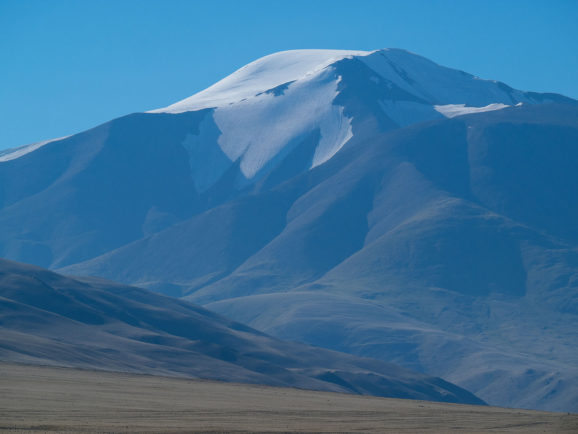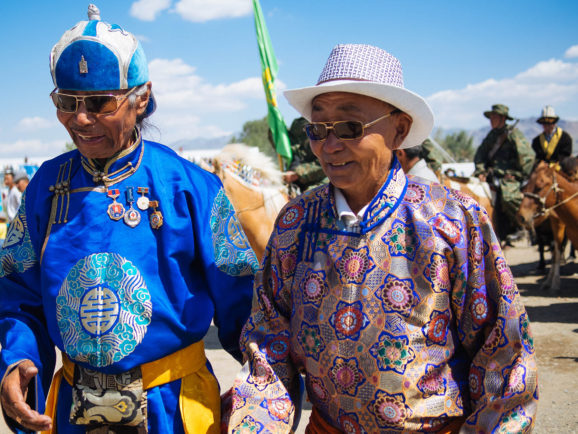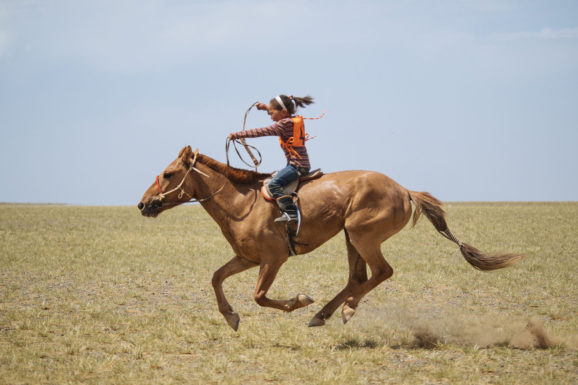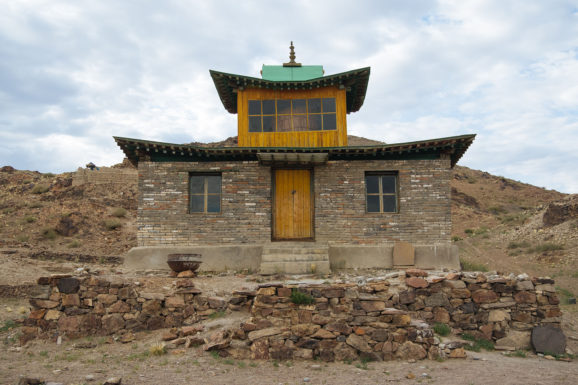The Empty Vessel

Our late model Landcruiser bumped along two wheel tracks toward the largest complex of sand dunes in Mongolia. Eleven miles of white sand sprawled in peaks and valleys, fronting the glorious granite Southern Altai Mountains. It was a clear morning, the sky cobalt blue save a few clouds, and that depth of field, the play of light and color made the whole scene look a set piece for a dream sequence; like a painting come to life.

For the first time in weeks I felt serene, as if the sheer majesty rocked me out of my body so I might float above my troubles. Soon the mountains disappeared and the dunes loomed ever larger until we landed at their doorstep. It takes three days to cross the dunes on foot, but just an hour to hike the highest one, which rises 300m above the Gobi Desert, so I kicked off my shoes, and began to climb.
Halfway up the slope my steady line began meandering like a drunk uncle. By then my heart was pounding and my lungs heaving. Also, my feet were on fire, thanks to a relentless sun growing stronger by the second, which heated the sand to scalding. Each time I stopped to catch my breath I took a swig of water and looked toward the top – my destination – where still more blonde sand swept into widow’s peaks sculpted by winds so strong they seemed to move through the middle of the thick dune itself. I could hear it moan and sigh. Hence the name: Khongryn Els: singing dunes.
Soon I was on all fours. The wind had intensified, which cooled the surface, but there were no more stolen glances upward lest stinging sand fill my eyes, nose and mouth. There was only groping, fighting and spitting, and the thought that if this were a dream sequence then perhaps my struggle was a metaphor.
Nothing had been easy lately. It had been just 18 months since the publication of my first book – my career highlight – yet my finances were once again teetering like a poorly stacked Jenga tower. A few recent indignities: my car had been broken into, my computer stolen, and my publishers had just rejected a follow up book proposal that would have solved my financial problems. My girlfriend knew things weren’t so great, but she didn’t yet know just how broke I was. In other words, for months I had been under siege from the warlords of my mind, and given that I was in crisis and I’m 45, it didn’t take long to question every life choice that had brought me to that point which helped me imagine a future filled with dead ends and dire prophecies.
It’s funny, the whole reason I chose a career that could offer excitement and adventure was to avoid the midlife crisis. I’d had a front row seat for my father’s. He was a good man, a career attorney, and he’s learned to love his life, but the midpoint was rough. Then again, perhaps these dunes, this country – Mongolia – was the perfect battleground? Maybe here in the vast desolation I’d find answers to what ailed me?

Before I left Ulaanbaatar, Mongolia’s capital, I met Zayasaikhan Sambuu, aka Zaya, one of Mongolia’s best painters. He grew up in a small Gobi town before ditching it to study art in the big city, thus launching a long walkabout all over the world. He splits his time between UB and Japan these days, but the desert still haunts him. “The Gobi to me, is an empty vessel,” he said. “You are going to listen yourself there.”
Emptiness is the first thing you feel when about three hours outside of the capital, you veer off the rutted tarmac, hit one of thousands of two wheel tracks that criss cross the steppe and enter the real business of the Gobi. This is where the sky opens up with limitless horizons and red earth sprouts nutritious grasses that feed countless cattle, sheep, shaggy yaks, painted horses with long elegant manes and tails, and herds of goats so thick they run like a river with no end. Their numbers had been multiplying thanks to the popularity of cashmere, one of the Gobi’s commodities that finds its way into international markets.

Out here livestock outnumbers people 100:1, and the animals were shepherded by nomadic families who in summer, and sometimes year round, lived in gers or yurts; lattice structures covered in canvass, and heated with a dung oven where they also prepare meals. Getting lost is inevitable when road tripping the Gobi, and we popped in on more than a few strangers for directions. We were always offered milky tea, with just a hint of salt. Sometimes hospitality was spiked with fermented camel’s milk, which tastes like a mixture of beer and yogurt (in a good way), and provides a slight buzz.
One morning at dawn, after sleeping in a guest ger owned by a local family, I emerged in time to watch a rising red sun with the faint echo of a billion stars in the sky. Nearby a herd of camels kneeled, just awake. Some wore their gnatty winter coat in patches, others had shed it clean. Their moans overlapped like devout monks chanting for absolution.
That was the morning we visited Tsagaan Suvraga, the White Stupa, a 400m long jigsaw of cliffs, mineral streaked purple, orange and red. I stood at the edge of one of them, and watched swallows soar and dive above a rolling landscape of color and earth, and I realized that when you’re feeling less than, getting kicked across the desert like a stone is good therapy.

For all its transporting emptiness, the Gobi has a story to tell. Dinosaurs roamed these plains back when it was a humid jungle, before the ice age descended. Much later it was an important link in the Silk Road. In fact it was Chinggis Khan, the man who formed the Mongolian nation state, whose warriors wrested control of the trade route from the Ottomans, and ushered in a period of Mongolian dominance on the world stage that stretched from China to Europe. A lasting by product was the infusion of Tibetan Buddhism into Mongolian culture. That religion remains a dominant force, and it migrated here in the hearts and minds of lamas who built dozens of monasteries throughout the Gobi.
For three weeks, I traveled by car and rail across the Gobi desert and walked among their ruins. In Baga Gazryn Chuluu, a nature reserve in the north Gobi, I walked red shale roads to the remains of Lovonchambyn Khiid, a temple complex reduced to crumbling mud walls, sprouting with sagebrush, tucked into a small aspen grove among red rock towers. Nearly all the ancient temples I saw in Mongolia, and I saw dozens, had been destroyed, and the monks massacred in the Stalinist purges of the 1930s. That’s when Mongolia leaned into the Soviet Union. Russian troops occupied the steppe for decades until the Cold War ended in the early 1990s, and it was safe for religion to come out of the closet.
That’s also when tourism first flickered to life, and when Nergui Chadraabal a 50-year old former government bureaucrat became a tour guide. His base of operations these days is the often overlooked, Ikh Nartiin Chuluu, a spectacular nature reserve in the East Gobi.
“This valley has been around for 650 million years,” Chadraabal told me as he toured me through his backyard in a beat up minivan. “It was once set beneath a prehistoric ocean stretching from Siberia to Korea.”



During the communist era, cement and coal were excavated from the area, but today the soil still glows with fragmented crystals, and it’s a wildlife haven, attracting tourists who come to see the argali, Mongolia’s native big horn sheep, gazelle, ibex, and, if they’re extremely lucky, wolves. Most stay at IkhNart Wilderness Camp, where Chadraabal works and where guests sleep in traditional guest gers upgraded with creature comforts. The beds are thick and soft, the furniture, posts and beams handprinted and tasteful, and the meals are delicious too. But it isn’t luxury so much as the blend of big nature and deep rooted culture that makes Mongolia so transporting.
Chadraabal, who spends his winters in the capital doing the books for a textile manufacturer, proved a sharp eye for wildlife. We swerved over a rise in time to see a herd of gazelle race between glacial rock formations. Their stride so long and swift their hooves barely touched the ground. He also pointed out petrified trees, ancient burial sites and petroglyphs depicting many of the animals that live there. Some were painted by early man, but the park is also suffused in 13th century history, which makes it a pilgrimage site for Buddhists.
August rains form ponds in the valley, which have always attracted migrating birds, and in the old days it also lured Silk Road caravans. An area monastery operated here for over a century and it’s believed that over 3000 monks once lived in the park. We saw prayer flags looped around rock outcrops, prayer beads left as offerings beneath swallow nests, and at a natural amphitheater we saw another petroglyph, a sacred verse, written in Sanskrit, which monks chant to this day. It read, “Om Mane Padme Hum.”

The Dalai Lama once described the practice, “as an indivisible union of method and wisdom, you can [use to] transform your impure body, speech, and mind into the pure exalted body, speech, and mind of a Buddha.”
Was that the code I needed; the evolutionary algorithm that leads to happiness and some kind of lasting peace? Maybe if I only sat in the desert, chanting like a bodhissatva my troubles would fade away?
Of course, to do that properly I’d have had to smash my iPhone, which at various points on the journey alerted me that North Korea tested a ballistic missile, Trump promised retribution, and that my house had been broken into. That last notification came in text form from my landlord, who wouldn’t be deferring rent, and I had to laugh at the absurdity of it all.
Because by then I’d heard that ten nomadic families live in the park and I’d seen their winter campsites. Their corrals and three-sided mud brick shelters were built into the rocks, alongside stacks of dung that would hopefully keep them warm all winter, when temperatures deep past 30 below zero. Yet despite obvious discomfort, if not hardship, contentment wasn’t elusive in rural Mongolia.

One nomad I met along the journey, a 53 year eagle hunter in West Mongolia named Shaaimurat Askhabil, shared his secret to remaining happy and balanced and avoiding the midlife crisis – a syndrome he’d never heard of – over a midnight feast prepared by his wife, Kulzira Jakhia. On a single patter was a pile of lamb, horse and cow meat he’d raised and slaughtered, and she’d dried and roasted. He sharpened two blades against one another and carved chunks that spilled over home meade noodles and potatoes glistening with fat. Ravenous, we all dug in with our fingers. It was the best meal I had in Mongolia, by far.
“People who live in the city, they buy everything with money,” he said, “so for them money is a source of stress. Here all we buy with money is flour and maybe some sweets, and we have no problems.”
His point was that since he ate his own meat, drank his milk – some of it fermented, and could pick up and move if he needed better land, he felt fulfilled and safe, and I believed him. Though he didn’t live in the Gobi, his mirror image was all over Mongolia’s southernmost province too.
Of course, their reality could never be mine, and I’m old enough to know there was no exotic lesson I could appropriate to counter my personal chaos. Sakhabil had built his life with years of hard work. After the Cold War ended, he, like all the other nomads, were given two animals and a pat on the back. Nothing more. Meanwhile an entire nation’s economic life crumbled before their eyes. Yet Mongolians like him endured privatization, and he’d earned every bit of his midlife satisfaction and security. I knew I would have to do the same.
I made it to the top of Khongryn Els, by the way, and on the peak I did an eagle dance, the ones I’d seen the Mongolian wrestlers perform upon victory, and enjoyed a superlative view Blades of light streamed through clouds over the vast desert. I felt present and alive, and ready to start again.